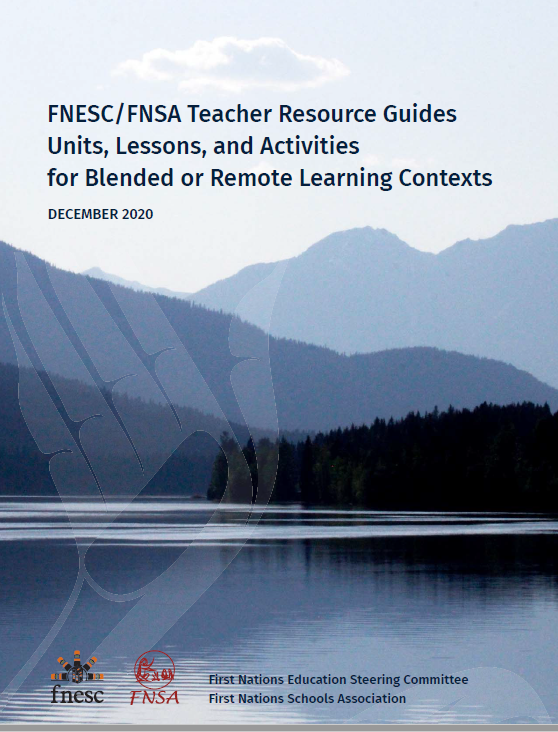The FNESC/FNSA Secondary Science First Peoples Teacher Resource Guide (2019) provides educators with resources to support the integration of the rich body of First Peoples (unappropriated) knowledge and perspectives into secondary Science classes (as well as other curricular areas).
The guide includes background information on how First Peoples’ knowledge and perspectives in science can be recognized and included in science inquiry. It also offers curriculum planning suggestions, and provides examples of fully developed multi-grade thematic units that correspond with the BC Science Curriculum for grades 10 to 12.
While it focuses on grades secondary grades, this guide can also be applied to other grade levels and be used in conjunction with the FNESC/FNSA Science First Peoples 5-9 Teacher Resource Guide.
It is recognized that the wealth of First Peoples’ science knowledge is held by communities. The guide can be used in conjunction with locally based resources that are developed by or in collaboration with, local communities. It is intended to be a starting place for educators.

For a hardcopy of this resource, please use our publications form to order. Quantities are limited.
We welcome feedback about our resources.
Adaptation Ideas
See FNESC/FNSA Teacher Resource Guides, Units, Lessons, and Activities for Blended or Remote Learning Contexts (Dec. 2020) for adaptation ideas relating to this publication. This guide is designed to identify the units, lessons and/or activities within FNESC/FNSA teacher resource guides that can be most readily adapted for remote or blended learning situations.

Resources
Foundations
1. Indigenous Knowledge, Indigenous Science
2. Involving Local Communities
3. Connecting with the Land
4. Finding and Using Narratives in the Science Classroom
5. Encouraging First Nations Learners’ Engagement in Science
6. Suggestions for Developing Locally Based Resources
7. Assessment Suggestions
Blackline Masters
Exploring Indigenous Science Perspectives
1-1 Indigenous Science
1-2 What is Traditional Ecological Knowledge?
1-3 Traditional Knowledge About Plants
1-4 Responsibilities to the Land
1-5 Thinking About Transformation
Transformation, Genetics and Evolution
2-1 Levels of Biodiversity
2-2 Combination Notes
2-4 Cladograms
2-5 Marine Animals
2-6 Forest Animals
Relationship to Fresh Water
3-1 Honouring Water
3-2 Understanding Watersheds
3-3 Water Sampling Investigation
3-3 Stream Study Recording Sheet
3-5 Design Thinking Template
3-5 Consequence Framework
Shaping the Land
4-1 Shaping the Land
4-2 Clam Gardens
4-3 Stone Fish Traps
Place-Based Ethnobotany
5-1 Sorting Nature
5-2 Plants as Indicators
5-3 Bitterroot and Indigenous Knowledge
5-4 Inquiry Using the 7Es
Salmon and Interconnectedness
6-1 Salmon Anatomy
6-2 Salmon Life Cycle
6-3 The Importance of Salmon Carcasses Study Questions
6-4 Salmon Habitat Sampling Data Recording Sheet
Connecting Food Security and Climate Change
7-1 Food and Climate Change Discussion Questions
7-2 Food Security
7-3 A Carbon Journey
7-4 Carbon Transformation Stations
7-5 Caribou Data File
Forests and First Peoples
8-1 Culturally Significant Trees of BC
8-2 Tree Classification
8-3 Petri Dish Mapping
8-4 Using a Biomass and Nutrient Calculator
8-5 Mapping Historical Forest Fires in British Columbia
Hunting and Trapping
9-1 Mammals of BC
9-2 Mammals of BC – Classified
9-3 Traditional Hunting and Trapping Technologies
9-4 Dead-Fall Trap Examples
9-5 Steps in Brain Tanning
Living Technologies
10-1 Traditional Technologies for Living
10-2 Frequency of Sounds Lab
10-3 First Peoples Technologies for Living
10-4 Digging Stick Technology
10-5 Pit Cooking Balsamroot
